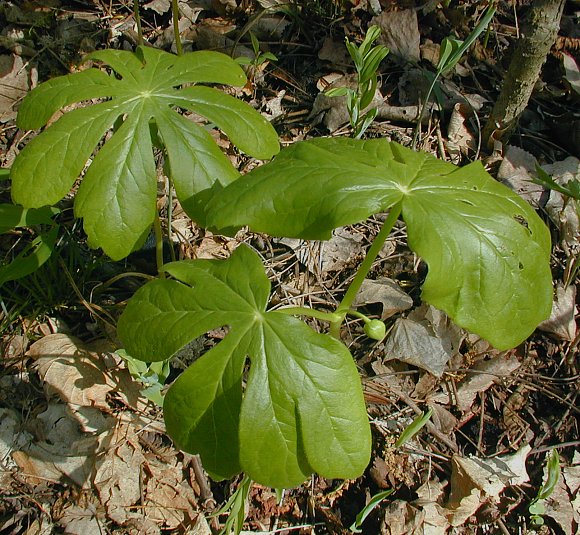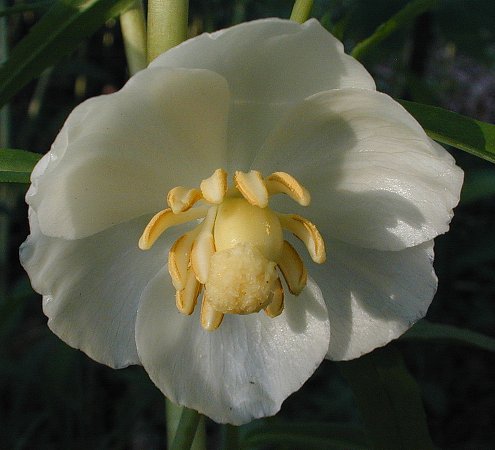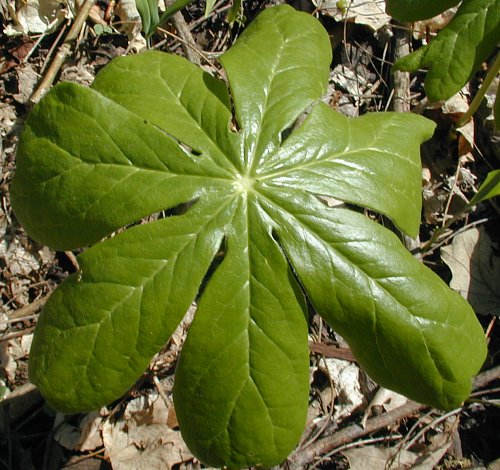Description: This herbaceous perennial plant is 1–1½' tall. Infertile plants are unbranched, producing a single leaf from a long stalk, while fertile plants produce a pair of leaves on long petioles at the apex of this stalk. The stalks are light green to pale reddish green, glabrous, and terete (circular in circumference). The leaves of infertile plants are up to 1' long and 1' across; they are orbicular in outline, fully peltate, and deeply divided in 6-9 palmate lobes. The leaves of fertile plants are similar, although they are less orbicular in outline, only marginally peltate, and they tend to have fewer lobes (typically 5-6). The leaves of both infertile and fertile plants have lobes that are obovate in shape. The outer margins of these lobes are coarsely dentate and often shallowly cleft; less typically, they are coarsely crenate, slightly undulate, or smooth (entire). The upper leaf surface is medium to dark green and glabrous. On fertile plants, the ascending petioles of the leaves are 3-6" long, light green to pale reddish green, glabrous, and terete. The petioles join the leaf blades toward the inner margins of the latter. Each fertile plant produces a single nodding flower where the 2 petioles branch from each other.

This flower is
about 1½" across, consisting of 6-9 white petals, 6 light green sepals,
12-18 stamens, and a superior ovary with a dome-shaped cluster of
stigmata at its apex. Both the petals and sepals are oval-obovate in
shape; the latter are glabrous and early-deciduous. The ovary is ovoid
in shape and light green to pale yellow. The stamens have white
filaments and yellow anthers. The pedicel of the flower is about 1½"
long, light green to yellowish green, and glabrous. The
blooming period occurs from mid- to late spring, lasting about 2-3
weeks. Individual flowers are short-lived; they have a pleasant
fragrance.
Each flower is replaced by an ovoid berry that is fleshy and contains
several seeds. At maturity, this berry is about 1½" long and pale
yellow. A berry is produced only when cross-pollination of the flower
occurs. The
root system is long-rhizomatous and fibrous. Mayapple often
produces dense colonial colonies that exclude other spring-flowering
plants.
Cultivation:
The preference is dappled sunlight to light shade, moist to slightly
dry
conditions, and a rich loamy soil with abundant organic matter. This
plant is easy to start from rhizomes and it will readily adapt to
garden areas near deciduous trees. It is a strong colonizer and may
spread aggressively in some situations. Young foliage is vulnerable to
late-frost damage. The mature foliage dies down by the end of summer.

Range &
Habitat:
The native Mayapple is a common plant that occurs in every county of
Illinois (see
Distribution
Map). It is found primarily in mesic deciduous woodlands,
open woodlands, small woodland openings, savannas, and edges of
hillside seeps in wooded areas. Mayapple occurs in high quality
old-growth woodlands and also open woodlands that have some history of
disturbance.
Faunal Associations:
The flowers are cross-pollinated by bumblebees and other long-tongued
bees. These insects collect pollen and possibly suck nectar. The larvae
of a sawfly, Aglaostigma
quattuordecimpunctatum, feed on the leaves of Mayapple
(Smith, 2006).
Adults of a thrips, Ctenothrips
bridwelli, have been found on the
foliage (Stannard, 1968). The foliage of Mayapple is avoided by
mammalian herbivores because of its poisonous qualities and bitter
taste. The seeds and rhizomes are also poisonous. The berries are
edible if they are fully ripe; they are eaten by box turtles and
possibly by such mammals as opossums, raccoons, and skunks. The seeds
are distributed to new locations in the feces of these animals.

Photographic
Location: A mesic deciduous woodland at Busey Woods in
Urbana, Illinois.
Comments:
Mayapple is a familiar woodland plant with interesting foliage. The
flowers are large and attractive, but they are sparingly produced and
mostly hidden by the large leaves. Mayapple develops very quickly
during the warmer days of spring. There is no
other plant within the state that resembles it; the only other species
in this genus occurs in Asia. People can eat the ripe berries in
limited
amounts, even though they may be mildly toxic. The flavor is bland and
resembles an overripe melon.